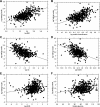Fasting insulin reflects heterogeneous physiological processes: role of insulin clearance
- PMID: 21632466
- PMCID: PMC3154529
- DOI: 10.1152/ajpendo.00013.2011
Fasting insulin reflects heterogeneous physiological processes: role of insulin clearance
Abstract
Several processes contribute to variation in fasting insulin concentration, including fasting glucose, insulin resistance, insulin secretion, and insulin clearance. Our goal was to determine the relative contribution of each of these insulin-related traits, plus anthropometric parameters, to fasting insulin among 470 Mexican Americans. The euglycemic hyperinsulinemic clamp yielded insulin sensitivity (M value) and metabolic clearance rate of insulin (MCRI). Acute insulin secretion was estimated by the insulinogenic index (IGI30) from the oral glucose tolerance test. Regression (univariate) and generalized estimating equations (multivariate) were used to describe the relationship of insulin-related traits to fasting insulin. Univarate analyses were used to select which traits to include in the multivariate model. In multivariate analysis, MCRI, M, BMI, waist circumference, and fasting glucose were independently associated with fasting insulin. Decreasing M and MCRI were associated with increasing fasting insulin, whereas increasing BMI, waist circumference, and fasting glucose were associated with increasing fasting insulin. Standardized coefficients allowed determination of the relative strength of each trait's association with fasting insulin in the entire cohort (strongest to weakest): MCRI (-0.35, P < 0.0001), M (-0.24, P < 0.0001), BMI (0.20, P = 0.0011), waist circumference (0.16, P = 0.021), and fasting glucose (0.11, P = 0.014). Fasting insulin is a complex phenotype influenced by several independent processes, each of which might have its own environmental and genetic determinants. One of the most associated traits was insulin clearance, which has implications for studies that have used fasting insulin as a surrogate for insulin resistance.
Figures
References
-
- Cagnacci A, Arangino S, Renzi A, Cagnacci P, Volpe A. Insulin sensitivity in women: a comparison among values derived from intravenous glucose tolerance tests with different sampling frequency, oral glucose tolerance test or fasting. Eur J Endocrinol 145: 281–287, 2001 - PubMed
-
- Cerutti F, Sacchetti C, Bessone A, Rabbone I, Cavallo-Perin P, Pacini G. Insulin secretion and hepatic insulin clearance as determinants of hyperinsulinaemia in normotolerant grossly obese adolescents. Acta Paediatr 87: 1045–1050, 1998 - PubMed
-
- DeFronzo RA, Tobin JD, Andres R. Glucose clamp technique: a method for quantifying insulin secretion and resistance. Am J Physiol Endocrinol Metab Gastrointest Physiol 237: E214–E223, 1979 - PubMed
-
- Despres JP, Lamarche B, Mauriege P, Cantin B, Dagenais GR, Moorjani S, Lupien PJ. Hyperinsulinemia as an independent risk factor for ischemic heart disease. N Engl J Med 334: 952–957, 1996 - PubMed
-
- Duckworth WC, Bennett RG, Hamel FG. Insulin degradation: progress and potential. Endocr Rev 19: 608–624, 1998 - PubMed
Publication types
MeSH terms
Substances
Grants and funding
LinkOut - more resources
Full Text Sources
Medical


